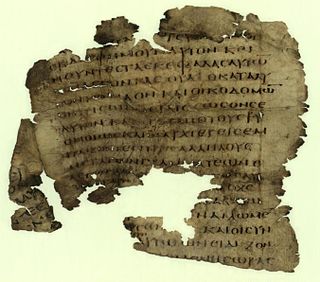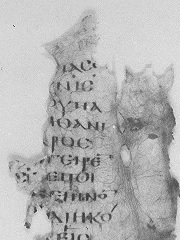 | |
| Text | 1 Thessalonians 4:16-5:5 |
|---|---|
| Date | 5th-century |
| Script | Greek |
| Now at | Austrian National Library |
| Size | 17 x 12 cm |
| Type | mixed |
| Category | III |
Uncial 0226 (in the Gregory-Aland numbering), is a Greek uncial manuscript of the New Testament. The manuscript paleographically had been assigned to the 5th-century. It contains a small parts of the First Epistle to the Thessalonians (4:16-5:5), on 1 parchment leaf (17 cm by 12 cm). It is written in two columns per page, 25 lines per page. [1]

A manuscript was, traditionally, any document that is written by hand -- or, once practical typewriters became available, typewritten -- as opposed to being mechanically printed or reproduced in some indirect or automated way. More recently, the term has come to be understood to further include any written, typed, or word-processed copy of an author's work, as distinguished from its rendition as a printed version of the same. Before the arrival of printing, all documents and books were manuscripts. Manuscripts are not defined by their contents, which may combine writing with mathematical calculations, maps, explanatory figures or illustrations. Manuscripts may be in book form, scrolls or in codex format. Illuminated manuscripts are enriched with pictures, border decorations, elaborately embossed initial letters or full-page illustrations. A document should be at least 75 years old to be considered a manuscript.

The New Testament is the second part of the Christian biblical canon, the first part being the Old Testament, based on the Hebrew Bible. The New Testament discusses the teachings and person of Jesus, as well as events in first-century Christianity. Christians regard both the Old and New Testaments together as sacred scripture. The New Testament has frequently accompanied the spread of Christianity around the world. It reflects and serves as a source for Christian theology and morality. Extended readings and phrases directly from the New Testament are incorporated into the various Christian liturgies. The New Testament has influenced religious, philosophical, and political movements in Christendom and left an indelible mark on literature, art, and music.

The First Epistle to the Thessalonians, usually referred to simply as First Thessalonians, is the thirteenth book from the New Testament of the Christian Bible. The first letter to the Thessalonians was likely the first of Paul's letters, probably written by the end of AD 52.
Contents
The Greek text of this codex is mixed. Aland placed it in Category III. [1]

A codex, plural codices, is a book constructed of a number of sheets of paper, vellum, papyrus, or similar materials. The term is now usually only used of manuscript books, with hand-written contents, but describes the format that is now near-universal for printed books in the Western world. The book is usually bound by stacking the pages and fixing one edge to a bookbinding, which may just be thicker paper, or with stiff boards, called a hardback, or in elaborate historical examples a treasure binding.

Kurt Aland, was a German theologian and biblical scholar who specialized in New Testament textual criticism. He founded the Institut für neutestamentliche Textforschung in Münster and served as its first director from 1959–83. He was one of the principal editors of Nestle-Aland – Novum Testamentum Graece for the Deutsche Bibelgesellschaft and The Greek New Testament for the United Bible Societies.
Currently it is dated by the INTF to the 5th-century. [1] [2]
The text of the codex was published in 1946 by Peter Sanz. [3]
Guglielmo Cavallo published a facsimile of the codex. [4]
Guglielmo Cavallo is an Italian Greek palaeographer and professor from the Sapienza University of Rome.
The manuscript was added to the list of the New Testament manuscripts by Kurt Aland in 1953. [5]
The codex currently is housed at the Austrian National Library, in Vienna, with the shelf number Pap. G. 31489. [1]








